With their gorgeous and vibrant colors and flowing fins, betta fishes are a sight to behold. No wonder they are so popular in the aquarium hobby. And to keep them happy and thriving, your bettas need more than a small bowl. Planted aquariums fulfill all of the requirements for a great betta environment.
Live plants are very beneficial to your betta fish. They provide O2, absorb toxins, keep the water parameters stable, give the bettas space to rest and explore, plus they’ll just look so good together.
Hornwort, Duckweed, Anubias, Amazon frogbit, etc are some of the best plants for betta fish tanks that you can get. But they aren’t the only ones.
Let’s check them out. Shall we?
10 Best Plants For Betta Fish Tank
Picking the best live plants for your beautiful betta fish aquarium can be a bit of a head-scratching task sometimes. And rightly so. After all, you only want to get what’s best for your adorable betta babies, right?
With all of these considerations in mind, I’ve prepared this list with the 10 best plants for betta fish tank that you can get. These plants are easy to grow, don’t require much maintenance, and will ensure a happy and healthy environment for your betta fish.
1. Java Fern

Starting with Java fern, one of the most popular plants in the craft of aquascaping. This hardy plant is low-maintenance and beginner-friendly. Narrow-leaf java fern, Needle leaf java fern, Trident java fern and Lace (windelov) java fern, etc. are some of its variants.
These variations have an effect on the size and shape of the leaf. Java fern can live happily in low light and doesn’t need loads of fertilizers to stay healthy. Filters and powerheads in the aquarium give ample oxygen for these plants; they don’t require a lot of CO2.
What makes Java fern an excellent choice for your betta fish tank is the fact that both the fish and the plant have similar needs. The ideal pH for Java fern is 6.0-7.0 and bettas require a pH of 7. So both will be pleased if you stick to 7 or slightly more acidic.
The ideal range for a betta tank temp is between 75-80 degrees Fahrenheit. And Java fern can live in water anywhere between 68-82 degrees Fahrenheit. So keep the tank temperature between 76-80 degrees Fahrenheit.
One common mistake many people make is burying the roots in the substrate. That’s a big no-no. Here is why.
Java fern is a rhizoid plant. Meaning, it has a green rhizome, which is a tentacle-like thick, horizontal stem with leaves on top and roots on the bottom. So, rhizoid plants don’t need substrates to grow. In fact, if you bury them in the grovel, they’ll turn into mush and die.
What you can do is, simply glue or tie the fern to any non-toxic driftwood or ornaments with a fishing line and leave them to grow. It’s that simple. In about 4-5 weeks, the rhizomes will get attached strongly and then you can remove the tie if you want to (once the plant grows, the tie won’t be visible anyway).
Java fern grows well on rough and bigger surfaces. The reason is more grip and room to spread. So, a smooth surface would work but it’d take more time to grow. And this fern already has slow growth.
Speaking of growth, java fern grows quite big and has wide leaves and will turn into a fern forest over time if you’re not careful. So it’d be better if you put them in the back of the tank and slightly out of the way of your bettas to swim. That way it’ll have plenty of space to grow and won’t be blocking your view from outside.
Another fun way to plant java fern is by letting it float freely on the water and it’ll look for things to latch onto and grow on them by itself.
Java fern creates this natural jungle vibe on your tank that your betta fishes will absolutely love to explore. Since they love to hide and it makes them feel secure. Plus they help with removing ammonia and are a natural harbor for helpful bacteria.
2. Marimo Moss Ball
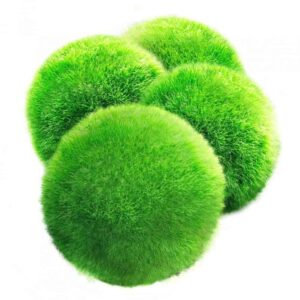
Next we have, one of my favorite, marimo moss balls. Marimo means “seaweed ball” in Japanese. But this is no seaweed or moss. It’s a type of algae found in the freshwater lakes and rivers of Japan and northern Europe. And it’s the prettiest bouncy ball you’ll ever see.
If you lack a green thumb or don’t want to put in a lot of effort, marimo moss ball is your answer. They are really easy to care for and inexpensive. To place it in the aquarium, all you need to do is give it a gentle rinse and then put it into the water. You don’t even have to anchor it with anything. Easy!
It’ll float at first and eventually drop to the bottom after being waterlogged. Marimo balls prefer low to medium light and cooler temperatures due to their natural habitat. They require few nutrients but you have to keep the water perimeters to their liking to avoid unwanted algae growth.
Just like any other plant they need clean, filtered water. Weekly water change would do the trick. While changing water, take the marimo ball out, rinse with aquarium/purified water, gently roll, and squeeze like a sponge to keep it from losing its shape.
Marimo balls are hardy and can endure occasional attacks and nibbling from curious fishes. So they are a favorite among shrimps and bettas. Your bettas would love playing with them, using them as resting spots, and building bubble nests around them.
They can also work as a filter, eliminating phosphates and particles from the tank, thanks to their spongy nature. They photosynthesize, just like many other plants; they take in carbon dioxide and emit oxygen while also consuming nitrates.
Cool and useful, marimo moss balls can be the perfect tank mate for your beautiful fish babies.
3. Hornwort

This lovely plant is versatile and quite fast-growing. They don’t have true roots so they can be rooted on the substrate or float around. Hornwort thrives on temperatures of 59-86 degrees Fahrenheit and moderate lighting.
This plant serves a variety of purposes, including absorbing extra nutrients and toxins, avoiding algal blooms, oxygenating the tank, and even encourages mating and provides safe haven for baby fishes.
Since they tend to be a bit delicate and grow fast, they need a little maintenance. You’ll need to trim them occasionally and have to be extra careful because you don’t want the bristles to float around all over the tank. You can catch the debris with a fine net of course but it’ll take a while and that can be annoying sometimes.
Another thing you need to keep in mind is that, if the plant is on the harder side, it can damage the betta’s fin. So be careful of that.
Other than these small inconveniences, hornwort can be a great beginner-friendly choice for your betta setup.
4. Water Wisteria – Hygrophile difformis

Something about water wisteria seems to bring out Bettas’s exploratory nature. This fast-growing plant provides your betta with shelter and new areas to sneak around and also oxygenates the water.
Wisteria is a hardy and low-maintenance plant. In the right water perimeters (low-moderate lighting, 74-82° F) it can grow up to 15-20 inches. Its vibrant green color can brighten up your whole aquarium.
Water Wisteria can be planted as a single-rooted plant or pruned into a foreground carpet. What’s more interesting is the fact that it can even alter the shape of its leaves based on how it is planted.
Now since they grow up pretty fast, this plant won’t hesitate to take over your entire tank if left unattended. So you’ll have to add trim to your weekly tank maintenance. Just like java moss, water wisteria can be used as great background plants.
5. Java moss

Java moss is a great plant for aquascaping since it is easy to install, grow and maintain. Just as java fern, java moss uses rhizoids to anchor themselves to the surface. And since this one too doesn’t have any true roots, it absorbs nutrients through stems and leaves.
Java moss can survive in a variety of water conditions and grows quickly (5-10cm) even without fertilizers and CO2. It prefers soft acidic water (pH 5.5-8.0) and a temperature of 59-82° Fahrenheit. It can thrive on a low lighting setup.
Warm light will cause it to grow slower and intense lighting will make it grow faster but that will also cause rapid algae growth and too much of it will result in dislodging and browning.
As java moss doesn’t need to be rooted in the substrate, you can just let it float away on the aquarium or tie it with a piece of ornament and let it grow there. You can also use java moss to create a green and soft carpeted look for your aquarium which will look phenomenal if done right.
Your betta will enjoy it as well because this moss will create a safe haven for them with plenty of space to explore.
6. Amazon Sword
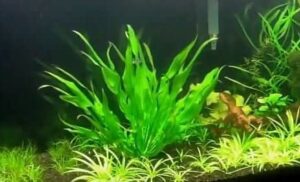
Originated from the amazon river basin, this plant got its name from its blade-like leaves. These broad leaves are the reason why the Amazon sword plant is a favorite among Betta fishes.
Usually used as a background plant, this one is very easy to grow and take care of, all thanks to their flexibility towards water conditions. They require a pH of 6.0-7.5 and thrive in 72-80° Fahrenheit which is very compatible with your bettas.
Under ideal circumstances, the amazon sword can grow up to 20” tall. So you should get a betta tank that is at least 10 gallons or up in terms of size to plant this one.
Because of their size, they can provide excellent hiding and resting spots for the fishlings. They create quite a unique backdrop in your aquarium. They also can be used to hide unsightly things like pipes and filters.
Unlike the two javas, we talked about earlier, the amazon sword needs to be rooted deep in the substrate. Their rootstock grows larger and stronger inside the substrate so beware of under gravel filters. Also, if you’re planting more than one, keep an adequate amount of space between two plants to give them enough room to grow.
This plant gets its nutrients from the substrate mostly so you’ll need to get quality iron-rich substrate to keep it thriving.
7. Anubias Nana
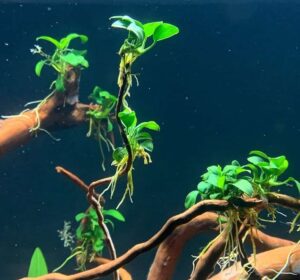
Anubias nana is another low-maintenance plant that can be an excellent addition to your betta tank. As with the amazon sword, this midground plant also has broad and wide leaves that bettas love to perch on to sleep and conserve energy.
Its hardy, dark green leaves can withstand any type of attack from your curious fishes. It’s very easy to care for. Just attach it with driftwood or rock and then drop it on water. Or you can also bury it on the substrate, just be careful not to bury the rhizome, as it will cause the plant to die.
Anubias nana is very compatible with the general water conditions of a home aquarium. It needs moderate lighting and can tolerate a temperature of 72-82° Fahrenheit and a pH level of 6.0-7.0.
If you’re a newbie aquarist or someone who isn’t very fond of pruning and trimming business, anubias nana can be THE plant for you. They stay very small (max growth 7-8”) and are notoriously slow growers. So no maintenance headache for you. yay!
8. Cryptocoryne Wendtii
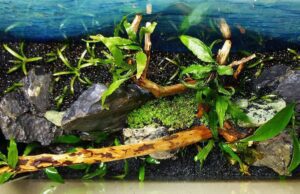
Originated from Sri Lanka, C. wendtii is a very underrated plant. It’s easy to care for and versatile.
This slow-growing species can grow up to 6-8 inches and thrives on low lighting and slow-moving water. Depending on how big your aquarium is, you can place this as a foreground or midground plant.
The large leaves provide excellent concealment. You can also create small tunnels from one side of the tank to the other using the smaller stems.
9. Duckweed

Entering the floating plant realm, first we have Duckweed! The frenemy of planted tank owners.
This delicate-looking plant is actually quite hardy and gives the tank a swampy, fluffy jungle look. It works as a great nutrient sponge by sucking up all the nutrients and toxins from the water. Duckweed also encourages male betta fish to build bubble nests for breeding purposes.
But, the reason they are frowned upon by many is, they grow really fast and will cover the entire tank if left unattended. This will block light and oxygen from entering the water which will be deadly for the plants and fishes underneath.
Also, cleaning Duckweeds is a mess. They get everywhere while water changing and the small tidbits like to stick with anything and everything. You can use a net to catch them all if you want to eradicate duckweed but it’s such an annoying process and you have to be thorough so that not even one duckweed escapes your net.
Other than this problem, duckweeds are pretty low maintenance and can survive in all water conditions and bettas love them. So I’d suggest you only get duckweeds if you have that time for maintenance and room to spare in your tank.
10. Amazon Frogbit
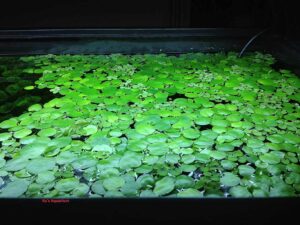
If you liked duckweeds, you’ll love this one. Amazon frogbit is a great alternative for duckweeds, as they are much bigger and have long dangling roots. This makes maintaining and weeding out much easier.
Your Betta fish will love swimming about the roots and up to the surface to play with the big leaves that float on top. The view of the tank from the outside also looks great.
This plant is hardy and as low maintenance as they get. Just don’t get overboard with it as it’ll block out the light and your betta’s access to the surface area.
Toxic plants for betta fish
There are a few plants that are poisonous to Betta fish that you should avoid. The majority of these plants are only dangerous if eaten, although certain plants can emit hazardous substances into the water. Let’s see what they are.
1. Lily of the Valley
If you are a fan of good ol’ garden cozies or just love Agatha Christie, you might be familiar with this semi-aquatic plant. Lily of the valley is extremely poisonous. Contains cardiac glycosides that cause heart failure, coma, or even death.
But the cute flowers and sweet fragrance might tempt you to take them home and keep them in your betta tank. DON’T. They are fatal for both humans and fish alike.
2. Peace lily
Peace lilies are another toxic plant you should steer clear of. Its juice and sap are toxic because of the high concentrations of calcium oxalate crystals. And it can cause severe intestinal problems if consumed.
Many pet shops keep peace lilies in the same vase as betta which is a very questionable practice. And that leads to some people believing the misconceptions that “bettas eat peace lily roots”. This is simply not true.
Bettas are by nature carnivores. And their main food is animal protein like larvae and insects. So they won’t survive on vegetation alone.
However, if you keep them in a small bowl paired with a peace lily, and if the betta is malnourished, they’ll nibble on the roots. Or maybe just out of curiosity. So, in order to avoid such accidents, don’t keep peace lily as a part of your Aquarium.
3. Devil’s ivy
Also known as pothos, devil’s ivy is another plant that contains calcium oxalate crystals. Pothos are popular among aquarists because of their ability to remove nutrients from the water.
But if your bettas like to nibble on plant roots, this plant can cause problems. The roots of devil’s ivy contain calcium oxalate that can cause an intestinal problem if ingested in even the slightest amount.
Moreover, due to their excellent biological filtration, sometimes they might suck up all the nutrients from the water, leaving the other plants to die.
4. Water Hemlock
Considered the most poisonous plant in North America, water hemlock is deadly for humans and animals alike. They contain a poison named “cicutoxin”. It is mostly found in tubers or roots, although it can also be found in leaves and stems.
The tuber releases a highly deadly brown or straw-colored liquid when cut or broken. This substance is poisonous. Just touching or handling it can be risky and if your betta accidentally eats even a small part of it, it’ll kill him.
5. Hygrophila Balsamica
Hygrophila balsamica releases toxic substances into the water from its roots, stems, and leaves while being above the water surface. These toxic chemicals are poisonous for fish and invertebrates.
Once Hygrophila balsamica has been underwater for an extended period of time, it will no longer be harmful. On the other hand, most aquatic plant nurseries grow their plants immersed, and it can be difficult to know how a plant was produced so it’s better not to take one home just to be safe.
Other considerations for a planted betta fish tank
While looking for live plants to buy for your betta fish tank, there are a few important variables to consider. Only when all the conditions are met, should you choose a plant as a tankmate for your betta. Stay with me, I’ll be showing you exactly what you need to make your tank a safe haven for betta fish.
First, you need to think about where you’re gonna place them. How big your betta tank is. Because a cramped tank decreases the life expectancy of betta fish. So, choose your plant accordingly.
Lighting is essential for your bettas and as well for plants. Bettas are diurnal. That means they stay active during the day and sleep at night. They prefer darkness during bedtime so choose plants that match the lighting requirements.
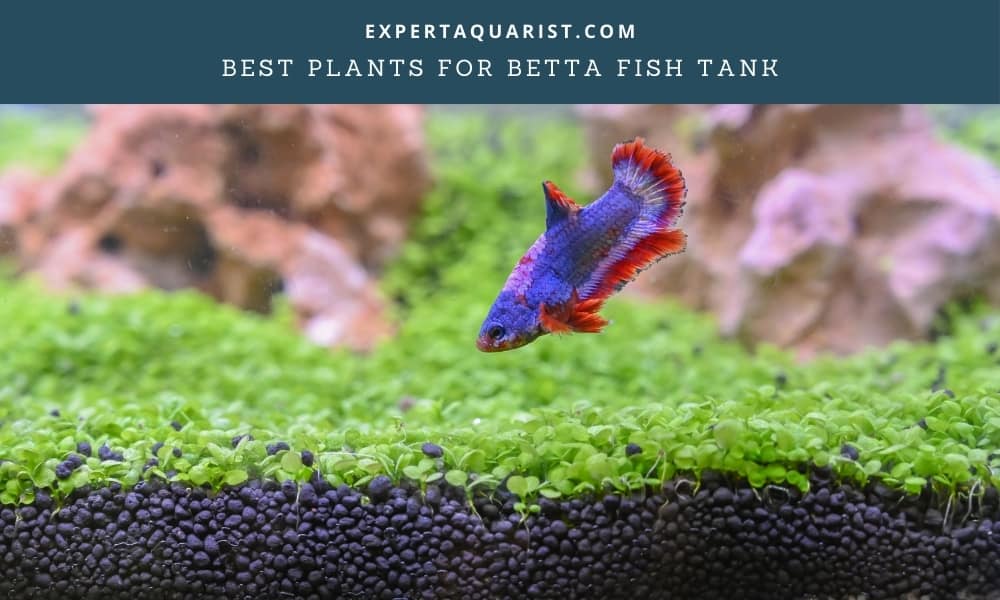
Do not get plants that have hard leaves or sharp edges to prevent your pet from getting hurt. Also, avoid plants that turn into a jungly mess as the fishes might get tangled and hurt themselves.
Another important thing you need to think about while selecting plants for your betta tank is how much time you can spare for maintenance. Because there are some plants that don’t need much maintenance while some plants grow up so fast that if you skip just one weekly pruning, they’ll take over the entire aquarium and block your betta from light and exploring.
You also need to check the plant’s water parameter compatibility. Bettas like warm and slightly acidic water so, it’d be best to get plants that have the same needs to maintain water condition stability.
Build the Best Planted Tank For your Betta
So there you are. No matter if you are a pro aquarist or someone who just started the hobby, these are the 10 best plants for betta fish tank that I think would be great to ensure the best and healthiest aquarium life for your pet. They deserve it.






